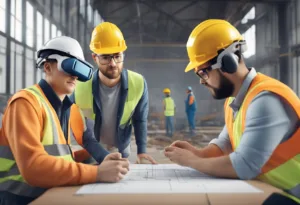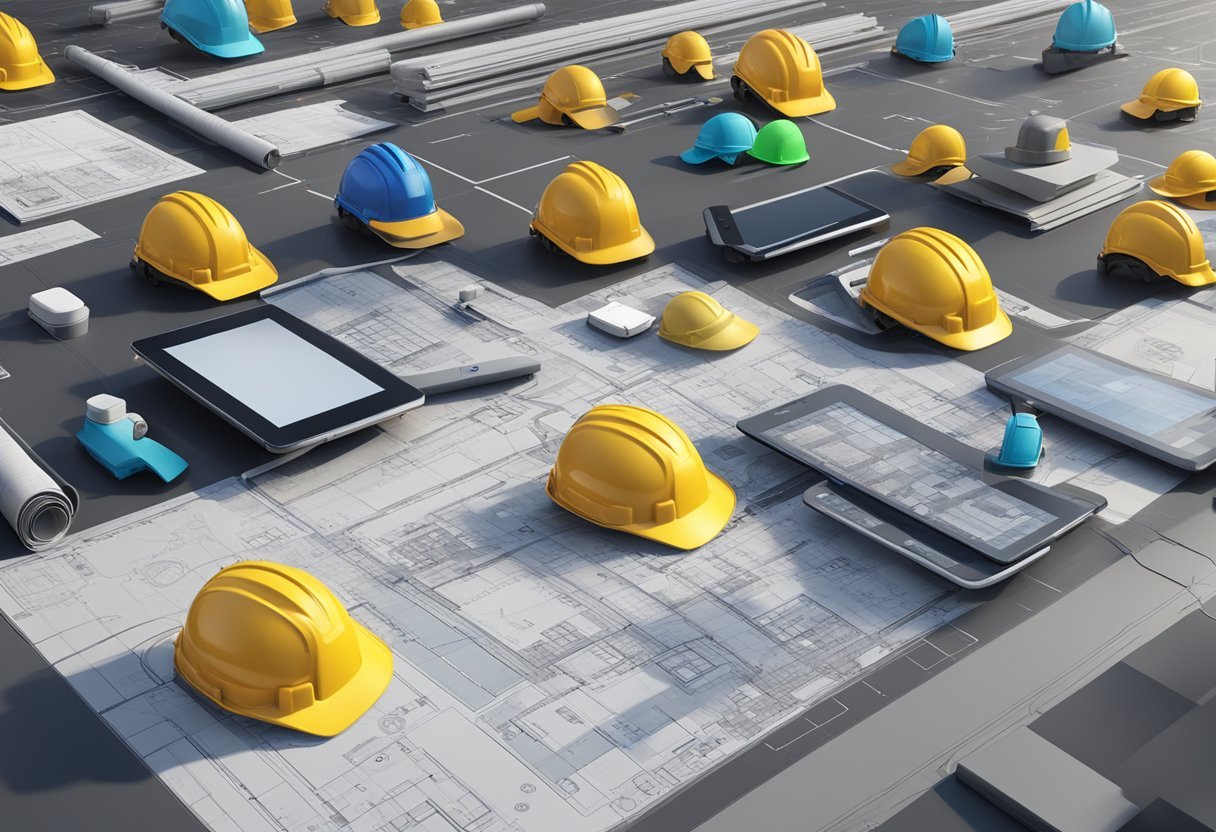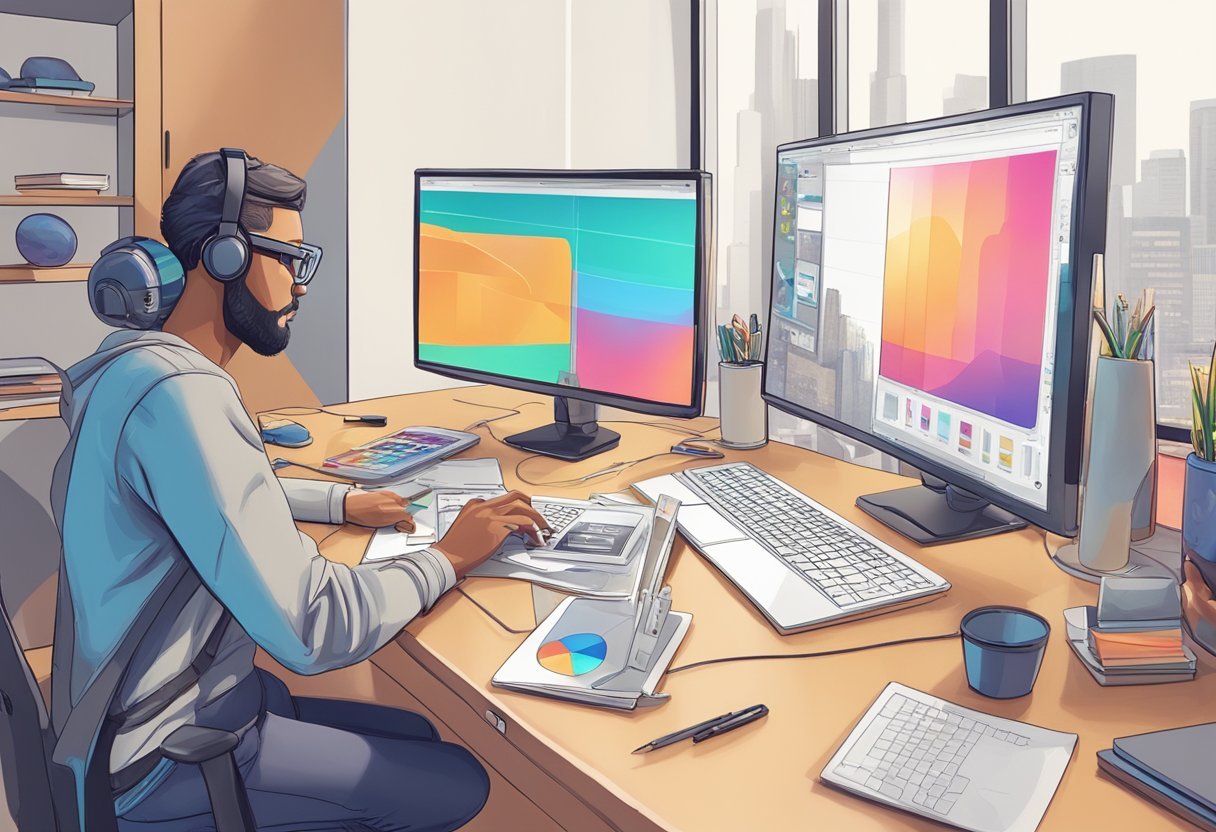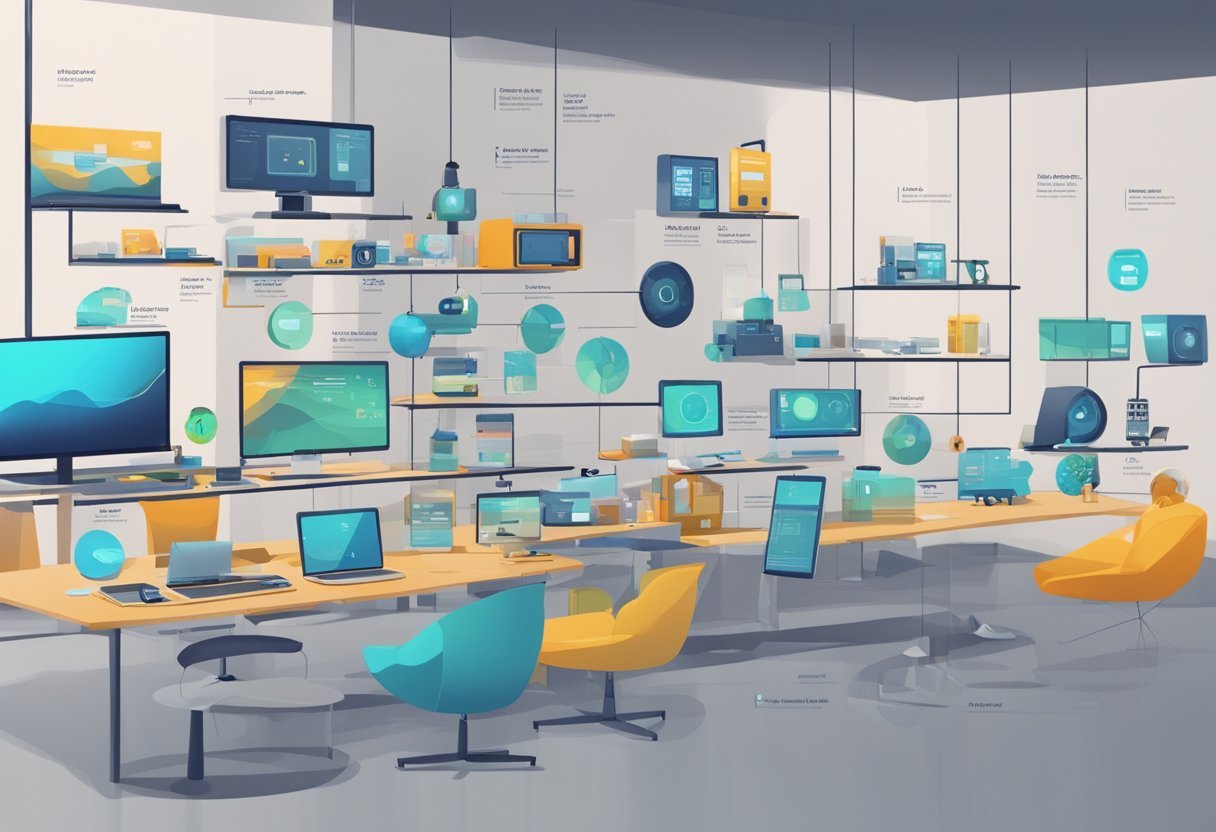Augmented Reality (AR) is a technology that has been gaining traction in the construction industry in recent years. AR involves the overlay of digital information onto the real world, creating a blended reality that allows users to interact with both the physical and digital environments. In construction, AR can be used for a variety of applications, from design and planning to improving safety and training on construction sites. In this blog post, I will discuss augmented reality in construction and share with you the benefits and limitations of AR in construction.
One of the benefits of using AR in construction is the ability to improve efficiency and accuracy in design and planning. With AR, designers and architects can overlay digital models onto the physical environment, allowing them to see how a building or structure will look in real life and make adjustments as necessary. AR can be used to provide virtual tours of a construction site, allowing stakeholders to get a better understanding of the project before construction even begins.
What is AR in Construction
Augmented Reality (AR) is a technology that overlays digital information onto the real world. In the construction industry, AR is used to enhance the visualization and understanding of building designs, construction plans, and project progress. AR technology combines the real world with computer-generated graphics to create a mixed reality experience.
How Augmented Reality Works in Construction
AR technology uses cameras, sensors, and software to track and analyze the physical environment. The software then generates digital information, which is projected onto the real world through a device like a smartphone, tablet, or AR glasses. This allows construction professionals to view and interact with digital objects in the real world.
AR in construction can be used to display details and elements on the construction plan. By visualizing working models, all parties involved succeed in creating a deep understanding of the project. AR technology can also be used to visualize the finished project in the real world before construction begins. This helps to identify potential issues and make necessary changes before construction starts.
AR Technology in Construction
AR technology benefits the entire construction team, including engineers, designers, architects, project managers, and service providers. AR Sketchwalk is an AR tool that allows designers to walk through their designs in the real world. This helps them to identify potential issues and make necessary changes before construction begins.
AR in construction may be leveraged to help firms win more projects, improve safety, and collaborate with team members. AR technology is a communication tool that can drive efficiency by uniting design and construction teams in a hybrid virtual environment, creating a shared experience. AR is useful across the entire design and construction process, from design conceptualization to ongoing operations and maintenance.
Benefits of Augmented Reality in Construction
Augmented Reality (AR) technology has the potential to revolutionize the construction industry by providing numerous benefits. Here are some of the benefits of using AR in construction:
- Enhanced Visualization
- Improved Accuracy and Precision
- Increased Efficiency and Productivity
- Better Training and Safety
- Real-time Collaboration and Communication
- Cost Reduction
- Reduced Errors and Rework
- Faster Project Approval and Client Buy-In
- Effective Maintenance and Facility Management
- Environmental Impact Assessment
Enhanced Visualization
Augmented Reality (AR) offers a significant benefit in construction through enhanced visualization. With AR, stakeholders can see a full-scale model of the proposed design overlaid onto the real construction site. This allows for a comprehensive understanding of how the finished project will look and interact with its surroundings. Enhanced visualization aids in identifying potential design issues early on, which can be addressed before construction begins, saving time and resources. It also helps clients and team members who may not be adept at reading traditional blueprints to visualize the end product, leading to better decision-making and satisfaction with the final outcome.
Improved Accuracy and Precision
AR technology brings improved accuracy and precision to the construction process. By overlaying digital information directly onto the physical environment, construction workers can follow exact specifications for installations, alignments, and measurements. This precision reduces the likelihood of human error and ensures that each element of the construction is executed according to the design plans. The use of AR for precision can lead to higher quality buildings and infrastructures that are built to last.
Increased Efficiency and Productivity
The use of AR in construction can significantly increase efficiency and productivity on the job site. By providing real-time, hands-free access to project data, blueprints, and 3D models, workers can perform their tasks more quickly and with fewer interruptions to consult paper plans or digital devices. AR can also streamline site inspections and progress monitoring, as it allows for quick comparisons between the model and the actual construction. This leads to a smoother workflow and the ability to complete projects faster, which is beneficial for both construction companies and their clients.
Better Training and Safety
AR technology enhances training and safety in the construction industry by providing interactive and immersive learning experiences. Workers can be trained on machinery, tools, and safety protocols through simulations that mimic real-world scenarios without the associated risks. This hands-on approach to training not only improves knowledge retention but also prepares workers for a variety of situations they may encounter on the job site. AR can be used to identify and alert workers to potential hazards in their immediate surroundings, promoting a safer work environment.
Real-time Collaboration and Communication
AR facilitates real-time collaboration and communication among construction project teams, which is vital for the success of any project. With AR, remote team members can view the same 3D models and project data as those on-site, enabling them to provide input and make decisions as if they were physically present. This seamless communication helps prevent misunderstandings and ensures that everyone is aligned with the project goals, leading to a more cohesive and efficient team effort.
Cost Reduction
One of the most compelling benefits of AR in construction is the potential for cost reduction. By improving accuracy, reducing errors, and enhancing efficiency, AR can significantly lower the overall expenses associated with construction projects. Fewer errors mean less rework and waste of materials, and increased efficiency translates to shorter project timelines and reduced labor costs. By catching design flaws early through enhanced visualization, costly mid-construction changes can be avoided.
Reduced Errors and Rework
AR’s ability to provide accurate overlays of digital models onto the physical environment helps in reducing errors and subsequent rework. This is especially beneficial in complex projects where precision is critical. By catching errors early, construction teams can address them before they become costly and time-consuming to fix. This not only improves the overall quality of the construction but also maintains project schedules and budgets, which are often strained by unexpected rework.
Faster Project Approval and Client Buy-In
The immersive visualization capabilities of AR can lead to faster project approval and client buy-in. Clients can better understand and visualize the proposed project in its real-world context, making it easier for them to appreciate the design and its impact. This clarity often results in quicker decision-making and approvals from clients and stakeholders, as well as from regulatory bodies that may require a clear understanding of the project’s scope and impact before giving the green light.
Effective Maintenance and Facility Management
Post-construction, AR can be an invaluable tool for maintenance and facility management. By accessing digital overlays of the building’s systems, maintenance personnel can easily locate and diagnose issues with structures or utilities. This capability makes the maintenance process more efficient, as it reduces the time spent searching for schematics or understanding complex systems. It also facilitates proactive maintenance by allowing for regular inspections that are more thorough and less intrusive.
Environmental Impact Assessment
AR can assist in assessing the environmental impact of a construction project by enabling teams to visualize the project in its intended setting before breaking ground. This visualization can help identify potential environmental concerns, such as the impact on local wildlife or water runoff patterns. By addressing these issues early in the planning phase, construction projects can be adjusted to minimize their environmental footprint, leading to more sustainable building practices and compliance with environmental regulations.
Limitations of Augmented Reality in Construction

While augmented reality (AR) has the potential to revolutionize the construction industry, there are still several limitations that need to be addressed before it can be widely adopted. Here are some of the limitations you should be aware of:
- High Initial Costs
- Technological Complexity and Integration Challenges
- Limited Field of View and User Discomfort
- Dependence on Environmental Conditions
- Resistance to Change and Adoption Hurdles
High Initial Costs
One of the primary limitations of implementing Augmented Reality (AR) in construction is the high initial costs associated with the technology. This includes the expense of purchasing AR devices, such as headsets and smart glasses, as well as the software development required to create the AR applications tailored to specific construction needs. Smaller construction firms may find these costs prohibitive, which can slow the adoption rate of AR technology within the industry. There are ongoing costs for maintenance, updates, and training that need to be considered, which can add to the total investment required to effectively utilize AR on construction sites.
Technological Complexity and Integration Challenges
AR technology involves a complex overlay of digital information onto the physical world, which requires a high level of technical expertise to develop and maintain. Integrating AR into existing construction processes and systems can also present significant challenges. Construction professionals must ensure that the AR software is compatible with current design and project management tools. This integration is essential for the seamless operation of AR applications, but it can be difficult to achieve, especially when dealing with legacy systems or software that is not designed to work with AR.
Limited Field of View and User Discomfort
Current AR headsets and smart glasses often have a limited field of view (FoV), which can restrict the user’s natural vision and make it difficult to fully engage with the augmented content. This limitation can hinder the effectiveness of AR applications in construction, where a broad and clear view of the physical environment is essential. Prolonged use of AR headsets can cause user discomfort, including eye strain and headaches, which can affect productivity and the willingness of workers to use the technology over extended periods.
Dependence on Environmental Conditions
AR technology relies heavily on environmental conditions to function correctly. Issues such as poor lighting, lack of visual markers, or interference from physical obstacles can disrupt the performance of AR applications. In outdoor construction environments, weather conditions like rain, fog, or bright sunlight can further complicate the use of AR. These environmental factors can lead to inaccurate overlays, misalignments, and reduced reliability of the AR technology, which can negate some of its benefits in construction settings.
Resistance to Change and Adoption Hurdles
The construction industry is often characterized by its adherence to traditional methods and resistance to change. Introducing AR technology requires a cultural shift and a willingness to adopt new ways of working. There can be significant hurdles in convincing management and on-site workers of the benefits of AR, and in providing the necessary training to use the technology effectively. This resistance can slow the adoption rate of AR and limit its potential impact on the industry. Overcoming these hurdles requires a clear demonstration of the return on investment and the long-term benefits of integrating AR into construction processes.
Limited Field of View
One of the main challenges of AR is the limited field of view. Users must wear a headset or use a mobile device to view the augmented reality content, which can be distracting and limit their ability to see their surroundings. This can be particularly problematic in construction sites where workers need to be aware of their surroundings to avoid accidents.
Technical Limitations
Another limitation of AR is the technical limitations. AR technology is still in its early stages, and there are still several technical challenges that need to be addressed. For example, AR devices may have difficulty tracking objects in complex environments, or the graphics may not be high enough quality to be useful.
Training
Finally, another limitation of AR in construction is the need for training. Workers need to be trained on how to use AR devices and software effectively, which can be time-consuming and expensive. Workers may be resistant to change and may be hesitant to adopt new technology.
While AR has the potential to transform the construction industry, it is important to be aware of these limitations and address them before implementing AR in construction projects. By doing so, you can ensure that your AR projects are successful and that you are able to take full advantage of the benefits that AR has to offer.
Applications in Design and Planning
Augmented Reality (AR) technology has revolutionized the way architects, engineers, and construction professionals design and plan their projects. By integrating AR into the design and planning phase, you can create a more detailed and accurate 3D model of your project. This section will cover two key applications of AR in design and planning: 3D Modeling and BIM Integration, and Project Visualization and Collaboration.
3D Modeling and BIM Integration
AR technology allows you to create a detailed 3D model of your project, which you can then view and manipulate in real-time. By incorporating AR into your design process, you can create a more accurate and detailed model of your project, which can help you identify potential design flaws and make necessary changes before construction begins.
AR technology also allows for seamless integration with Building Information Modeling (BIM) software such as Autodesk Revit and Fusion 360. By integrating AR with BIM, you can create a more detailed and accurate model of your project, which can help you identify potential design flaws and make necessary changes before construction begins.
Project Visualization and Collaboration
AR technology also allows for more effective project visualization and collaboration. By creating a detailed 3D model of your project, you can use AR to visualize the project in real-world environments. This can help you identify potential design flaws and make necessary changes before construction begins.
AR technology also allows for more effective collaboration between architects, engineers, and construction professionals. By creating a shared AR model of the project, all stakeholders can view and manipulate the model in real-time, allowing for more effective collaboration and communication throughout the design and planning phase.
AR technology has transformed the way architects, engineers, and construction professionals design and plan their projects. By incorporating AR into the design and planning phase, you can create a more accurate and detailed model of your project, which can help you identify potential design flaws and make necessary changes before construction begins. AR technology allows for more effective project visualization and collaboration, which can lead to more efficient and successful projects.
Enhancing Construction Site Efficiency with AR
Augmented Reality (AR) technology is transforming the construction industry by providing real-time information and enhancing on-site decision-making. AR is revolutionizing the way construction professionals work, making it easier to manage equipment and resources, reduce errors, and improve overall efficiency.
Real-Time Information and Error Reduction
AR technology enables construction professionals to visualize and interact with Building Information Modeling (BIM) models using mobile devices or AR headsets such as the HoloLens, Gamma AR, or VisualLive. This allows for real-time inspection and error detection, reducing the need for rework and increasing efficiency.
With AR, you can overlay virtual information and 3D models onto the real-world environment, providing context-aware data and visualizations. This helps to reduce human-made errors, lack of experience, and poor management, which are common factors that cause low productivity in the construction sector.
Equipment and Resource Management
AR technology also helps to manage equipment and resources more efficiently. By using AR, you can track equipment and resources in real-time, reducing the risk of theft or loss. AR technology also helps to optimize equipment and resource usage, reducing downtime and increasing productivity.
With AR, you can also use virtual reality to simulate construction scenarios, allowing you to plan and optimize the use of equipment and resources before construction begins. This helps to reduce waste, increase efficiency, and save time and money.
AR technology is transforming the construction industry by enhancing visualization capabilities and enabling on-site decision-making. By using AR, you can improve efficiency, reduce errors, and optimize equipment and resource management.
Improving Safety and Training in Construction with AR
Augmented reality (AR) technology has the potential to revolutionize safety and training in the construction industry. By providing workers with real-time information and visual aids, AR headsets can help improve safety protocols and training, as well as streamline inspections and compliance procedures.
Safety Protocols and Training
AR headsets can be used to provide workers with on-the-job safety training, allowing them to learn and practice safety protocols in real-time. For example, workers can use AR headsets to simulate hazardous scenarios and learn how to respond appropriately. AR headsets can also provide workers with visual aids and step-by-step instructions for performing tasks safely.
In addition, AR headsets can be used to monitor workers’ safety in real-time. For example, safety helmets equipped with AR technology can detect when a worker is in a hazardous area and alert them to potential dangers. This can help prevent accidents and injuries on the job.
Inspections and Compliance
AR technology can also be used to streamline inspections and compliance procedures. For example, inspectors can use AR headsets to quickly and easily identify potential safety hazards in a construction site. AR headsets can also be used to provide inspectors with real-time data and visual aids, allowing them to make more informed decisions.
AR technology can also help ensure compliance with safety regulations and standards. For example, AR headsets can be used to provide workers with real-time reminders and instructions for complying with safety protocols. AR technology can also be used to track and monitor compliance, allowing construction companies to identify potential issues and take corrective action.
AR technology has the potential to significantly improve safety and training in the construction industry. By providing workers with real-time information and visual aids, AR headsets can help improve safety protocols and training, as well as streamline inspections and compliance procedures.
The Future of AR in Construction
Innovation and Market Trends
As the construction industry continues to evolve, augmented reality (AR) is becoming an increasingly popular tool for engineers and construction workers. AR has the potential to revolutionize the way construction projects are planned, designed, and executed. With AR, engineers and architects can create 3D models that can be overlaid onto real-world environments, allowing for more accurate and efficient planning.
In addition, AR can be used to streamline collaboration and communication between different teams involved in a construction project. With AR, all team members can see the same 3D model in real-time, allowing for more efficient decision-making and problem-solving.
Market trends indicate that the adoption of AR in the construction industry is on the rise. According to a report by MarketsandMarkets, the global AR and virtual reality (VR) market in the construction industry is expected to grow from $1.4 billion in 2019 to $4.7 billion by 2024, at a CAGR of 27.1% during the forecast period.
Challenges and Potential for Growth
While AR has the potential to transform the construction industry, there are also challenges that need to be addressed. One of the biggest challenges is the cost of implementing AR technology. AR hardware and software can be expensive, and many construction companies may not have the budget to invest in this technology.
Another challenge is the need for specialized training. AR technology is still relatively new, and many construction workers may not have the necessary skills to use it effectively. This means that companies may need to invest in training programs to ensure that their employees can use AR technology to its fullest potential.
Despite these challenges, the potential for growth in the AR market in the construction industry is significant. As the technology becomes more widespread and more affordable, we can expect to see more companies adopting AR as a tool for planning and executing construction projects. With its ability to streamline collaboration and communication, AR has the potential to revolutionize the way construction projects are completed.
Frequently Asked Questions
How does augmented reality enhance project management in construction?
Augmented reality can enhance project management in construction by providing real-time information and data visualization to project managers. With AR technology, project managers can monitor progress, identify potential issues, and make informed decisions in real-time. AR can also be used to improve collaboration and communication among team members, reducing the likelihood of errors and delays.
How is augmented reality used in the construction industry?
Augmented reality is used in the construction industry in various ways, including design visualization, safety training, and on-site construction guidance. AR technology allows architects, engineers, and contractors to visualize and manipulate 3D models of buildings and structures, improving the accuracy and efficiency of the design process. AR can also be used to simulate hazardous scenarios, allowing workers to practice safety procedures in a safe and controlled environment.
Which construction companies are pioneering the use of augmented reality technology?
Several construction companies are pioneering the use of augmented reality technology, including Skanska, Mortenson, and Gilbane. These companies have implemented AR technology in various aspects of their operations, from design visualization to on-site construction guidance.
Can you provide a case study where augmented reality has significantly impacted construction processes?
One example of augmented reality significantly impacting construction processes is the use of AR technology by the construction company Mortenson. Mortenson used AR to visualize and optimize the installation of mechanical, electrical, and plumbing systems in a hospital construction project. The use of AR technology allowed Mortenson to reduce the installation time by 60%, resulting in significant cost savings and improved project efficiency.
What are the primary benefits of implementing augmented reality in construction projects?
The primary benefits of implementing augmented reality in construction projects include improved project efficiency, reduced costs, improved safety, and enhanced collaboration and communication among team members. AR technology allows for real-time information and data visualization, reducing the likelihood of errors and delays. AR can also be used to simulate hazardous scenarios, improving worker safety and reducing the risk of accidents.
What are the key distinctions between augmented reality (AR) and virtual reality (VR) in the context of construction?
The key distinction between augmented reality (AR) and virtual reality (VR) in the context of construction is that AR overlays digital information onto the real world, while VR creates a completely virtual environment. AR is typically used for on-site construction guidance and design visualization, while VR is primarily used for pre-construction design and planning.




